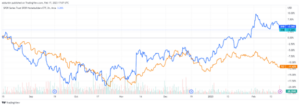Market “Divergences”
February 17, 2023
To Inform:
Markets take a circuitous path to the future. Investing is rarely a “linear” discipline. It’s better thought of as a “chaos system” akin to understanding the weather. In less scientific terms, markets are a “whack-a-mole” of risks and opportunities, all presenting themselves at different times and in varying fashions. Sometimes markets behave rationally, other times the market sends a variety of signals that something might be amiss. Commentators refer to these signals as “divergences”.
One such divergence is in the response to higher interest rates lately from growth stocks. As interest rates rose through 2022, growth stocks were hardest hit. With so much of their cash flows occurring in years long into the future, they are the most sensitive to rising interest rates.
The chart below shows the performance of an index comprised of long duration bonds and an index of large growth stocks. The important thing to note is how similarly these two indexes behaved over the last year. When interest rates were going up, bond prices (orange) and growth stocks (blue) were going down. After this month’s rise in interest rates (both short and long term) bonds began declining again, but growth stocks have remained somewhat resilient. An astute commentator would point this out as a divergence, an “oddity” and ask, “where else are we seeing such behavior?”

Source: TradingView
The behavior of home building stocks in recent weeks has been curious. The chart below shows the same bond index in orange (which goes down when interest rates are up) and a basket of home building stocks in blue. While they traded in a very similar fashion with bond prices last year, we’ve since seen home building stocks diverge from what’s been happening with interest rates. While rates are up modestly this month home building stocks have been strangely resilient.

Source: TradingView
Why the divergences? I think in periods where uncertainty is high the market tends to see strange divergences. The market simply doesn’t know how to respond to conflicting data and an uncertain future. Data in recent weeks is beginning to change the narrative from hard landing (sharply declining inflation and recession) to soft landing (slowing inflation, slow but steady economic growth) to “no landing” (sticky inflation, no recession). Until this week, markets seem to have been pricing in a soft landing. With stronger jobs, retail spending, and inflation data in recent days the risk of higher interest rates for longer seems to be getting some attention.
How should an investor respond in such a highly uncertain environment? I would argue that times like this argue for neutrality. In the portfolios we have the privilege of managing on behalf of our clients we have in recent months moved many of our asset class allocations closer to neutral. While this recent move higher in interest rates is bad in the short term for bonds, it also means much higher levels of income and better forward rates of return. And while stocks tend to get dinged by rising interest rates, some corners of the market tend to weather these periods better than others (think dividend payers and/or quality businesses with clean balance sheets). One benefit in watching for and understanding these divergences is that it helps us manage risk in portfolios. Eventually, the clouds clear and the market gives clearer signals. Until then, we’re going to be playing things a little closer to the vest.

Written by Alex Durbin, Portfolio Manager